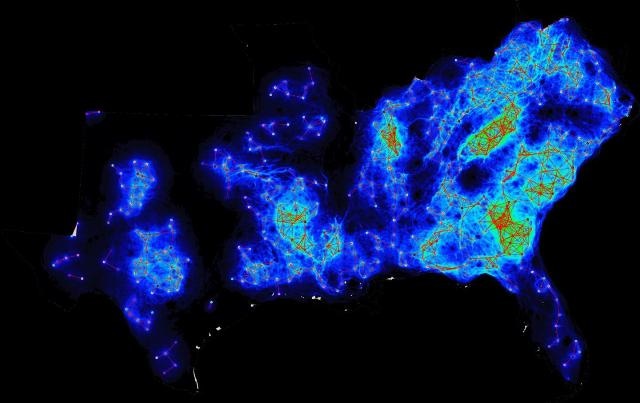Jun 21 2016
Clemson University scientists Paul Leonard and Rob Baldwin are part of a collaborative study on how rising sea levels and increased urbanization — both now and in the future — are joining forces to fragment habitat connectivity across the region.
 High-resolution connectivity maps designed at Clemson University display the potential corridors used by animal populations to move between both large and small areas. (CREDIT: Paul Leonard and Edward Duffy / Clemson University)
High-resolution connectivity maps designed at Clemson University display the potential corridors used by animal populations to move between both large and small areas. (CREDIT: Paul Leonard and Edward Duffy / Clemson University)
Leonard, Baldwin and four other co-authors contributed to the paper, “Landscape Connectivity Losses Due to Sea Level Rise and Land Use Change,” about wildlife habitat connectivity in the Southeast that has been published in the journal Animal Conservation.
By the year 2100, sea levels might rise as much as 2.5 meters above their current levels, which would seriously threaten coastal cities and other low-lying areas. In turn, this would force animals to migrate farther inland in search of higher ground. But accelerated urbanization, such as the rapidly expanding Piedmont area that stretches from Atlanta to eastern North Carolina, could cut off their escape routes and create climate-induced extinctions.
Protecting the environment
“This is the first time we’ve been able to combine these multiple threats to predict how future land-use change and aspects of climate change, such as sea-level rise, are interactively altering the landscape connectivity picture for multiple species,” said Leonard, a postdoctoral scientist at Clemson University. “In our models, we focused on six different species — black bear, red wolf, Eastern cougar, Eastern diamondback rattlesnake, timber rattlesnake and pine snake — and grouped them based on the way they move around the landscape. We then looked at how increased urbanization and sea-level rise would work together to change the picture of connectivity in the future.”
Much of the manuscript is based on data produced by high-resolution connectivity maps that were designed at Clemson University. These maps were paired with satellite imagery to display the potential corridors used by animal populations to move between both large and small areas. Also, more than 60 highly regarded biologists provided additional data by sharing their accumulated expertise, completing surveys and answering follow-up questions. The manuscript emphasizes that using corridors to reconnect fragments of natural habitat is essential for promoting the survival of many species. It further states that present and future threats to biodiversity have created an urgent need to protect and restore these habitats.
“As well as researching what is happening now and what will likely happen in the future we are also suggesting ways to significantly improve conservation decision-making across the South Atlantic region,” said Baldwin, the Margaret H. Lloyd-Smart State Endowed Chair in the forestry and environmental conservation department at Clemson University. “Habitat connectivity is going to change based on rising sea levels and increased urbanization, the latter of which will shift and move as a result of sea-level rise. So we have two things that are playing major roles in the fragmentation of habitat. But based on our connectivity maps, today’s conservation land trusts and government agencies will be better informed to prioritize ways to create and preserve corridors that will allow animals to move to more optimal habitats as conditions change in the future.”
The South Atlantic region is impressively rich in biodiversity, but many of its native plants and animals are under siege. The results of the study suggest that restoring and maintaining “robust and resilient” connections between existing fragments of natural habitat could create networks that are large and interconnected enough for species to continue to thrive. But according to Leonard, the major finding of the study is that an overwhelming fragmentation of core areas and corridors for the target species will occur in the future if the predicted scenario becomes reality.
“We lay out the implications for how sea-level rise and urbanization are interacting to cause this large fragmentation on the landscape and present problems for the future movement of animals,” Leonard said. “But at the same time, our results highlight the places where we can take action now to prevent the scenario that we see in 2100. So we’re not helpless; but neither can we afford to just sit on our hands and do nothing.”
The four other co-authors of the paper, which was released online on June 13 by Animal Conservation, are Ron Sutherland and Alison Montgomery of the Wildlands Network, Derek Fedak of Colorado State University and Rachael Carnes of the California Wolf Center. The manuscript, which will appear in print on June 24, summarizes the results of a three-year investigation of wildlife connectivity priorities funded by the South Atlantic Landscape Conservation Cooperative, which is a partnership that brings together federal, state and local organizations across six states – Virginia, North Carolina, South Carolina, Georgia, Alabama and Florida – to foster shared conservation action among public and private organizations. The South Atlantic LCC is part of a broader network of 22 cooperatives across North America and the U.S. Pacific and Caribbean islands, each having the same goal of organizing collaborative conservation efforts.
“The LCC system is really interesting in the way it’s bringing together a lot of different groups to tackle these enormous problems,” said Baldwin, associate professor of conservation biology and GIS at Clemson University. “For example, the South Atlantic LCC is trying to stimulate science, such as Paul’s project. It’s also bringing in groups like the Wildlands Network and Nature Conservancy, which are nonprofits, as well as universities like Clemson, which have the resources to do the kinds of research that will support and enhance decision-making in the future.
“The overarching goal is to think large-scale by pulling people together across state lines. This caliber of cooperation will help conservationists to find substantial new sources of funding to protect habitat corridors across the South Atlantic region.”